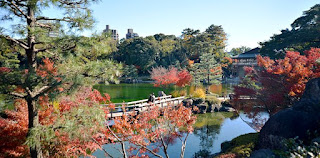With over two million inhabitants, Nagoya (名古屋) is Japan's fourth most populated city. It is the capital of Aichi Prefecture and the principal city of the Nobi plain, one of Honshu's three large plains and metropolitan and industrial centers.
Nagoya developed as the castle town of the Owari, one of the three branches of the ruling Tokugawa family during the Edo Period. Much of the city, including most of its historic buildings, were destroyed in the air raids of 1945. The Toyota Motor Corporation maintains its headquarters just outside of Nagoya.
1. Nagoya Castle
 |
| Nagoya Castle |
Nagoya Castle was built in the beginning of the Edo Period as the seat of one of the three branches of the ruling Tokugawa family, the Owari branch. As such, it was one of the largest castles in the country, and the castle town around it ultimately grew to become Japan's fourth largest city.
Most castle buildings were destroyed in the air raids of 1945, including the castle keep and the palace buildings. The current ferro-concrete reconstruction of the castle keep dates from 1959 and contains a modern museum with exhibits about the castle's history. The park surrounding the castle keep features two circles of moats and impressive walls with corner turrets. It becomes an attractive hanami spot during the cherry blossom season which usually peaks in late March or early April.
 |
| Nagoya castle restoration |
In 2009, works began on the ambitious project to rebuilt the castle's palace (Honmaru Goten) using traditional construction materials and techniques. A first part of the reconstructed palace, including the entrance and main audience hall with beautiful replicated paintings on the sliding doors (fusuma) were completed and opened to the public in May 2013. The rest of the palace is scheduled to open in 2016 and 2018.
During the reconstruction works, castle visitors are allowed to enter the scaffolding structure and observe the reconstruction works from a raised corridor except on Tuesdays and Thursdays. This provides a unique opportunity to observe traditional construction techniques and should not be missed.
2. Tokugawa Art Museum
 |
| Tokugawa garden |
During the Edo Period (1600-1868), Nagoya served as the seat of the Owari, one of the three major branches of the ruling Tokugawa family. The family amassed great wealth that was only surpassed by four of the 200 feudal domains of the Edo Period. The Tokugawa Art Museum was built on the grounds of the Owari's former feudal residence and preserves and exhibits several of their treasures including samurai armor and swords, tea utensils, noh masks and costumes, poems, scrolls and maps.
Next to the museum is Tokugawa-en, a beautiful Japanese landscape garden with a large pond at its center. The garden used to be part of a retirement residence of the local lords, but was destroyed during the war. In 2001 the garden was restored and reopened to the public in 2004. A large network of walking trails lead around the grounds to a tea house, rest houses, and across several bridges. The garden is best in spring, when its Peony (mid to late April) and Iris gardens (late May to early June) bloom, and during the autumn season (November).
3. Osu Kannon Temple
 |
| Osu Kannon Temple |
Osu Kannon (大須観音, Ōsu Kannon) is a popular Buddhist temple in central Nagoya. Originally built during the Kamakura Period (1192-1333) in neighboring Gifu Prefecture, the temple was moved to its current site by Tokugawa Ieyasu in 1612 after the original temple had been repeatedly damaged by severe flooding. The current buildings are 20th century reconstructions.
The main object of worship at the temple is a wooden statue of Kannon, the goddess of mercy, which was carved by Kobo Daishi, an instrumental figure in Japanese Buddhism. Underneath Osu Kannon's main hall is the Shinpukuji Library which contains over 15,000 classic Japanese and Chinese texts. Among these texts are several national treasures and important cultural properties, including the oldest copy of the Kojiki, a chronicle of the early history of Japan including its mythological origins.
A flea market is held on the temple grounds on the 18th and 28th of every month. The modestly sized market includes around 60 stalls selling everything from souvenirs and antiques to clothes and second hand goods. Just beside the temple is the entrance to the Osu Shopping Arcade, a network of aging but charming covered shopping streets with over 400 shops and restaurants. The area is sometimes compared to Tokyo's Akihabara district as there are a lot of stores that specialize in electronics, cosplay, anime, J-pop and idol goods.
For more info : Japan Guide















0 comments:
Post a Comment